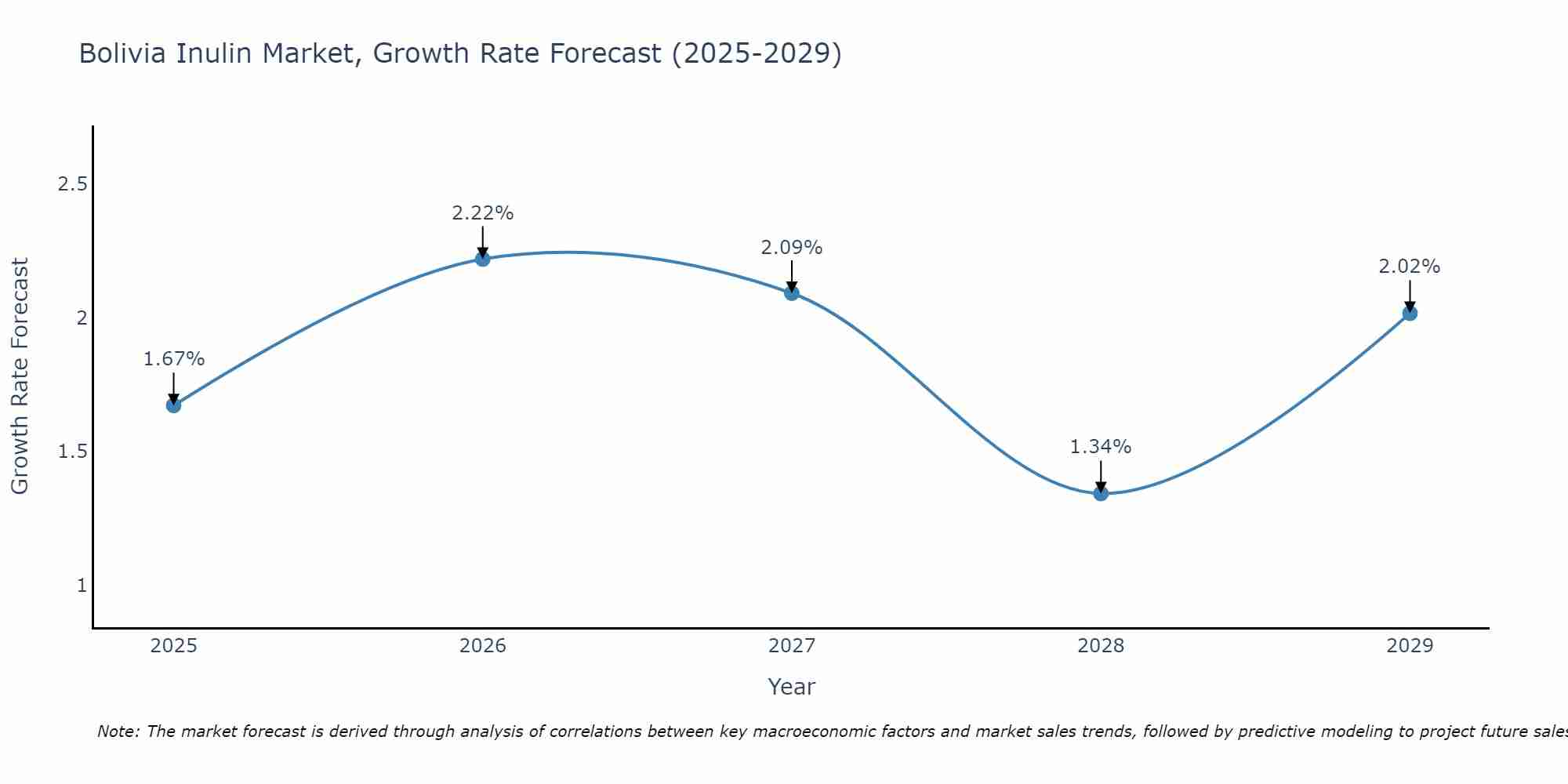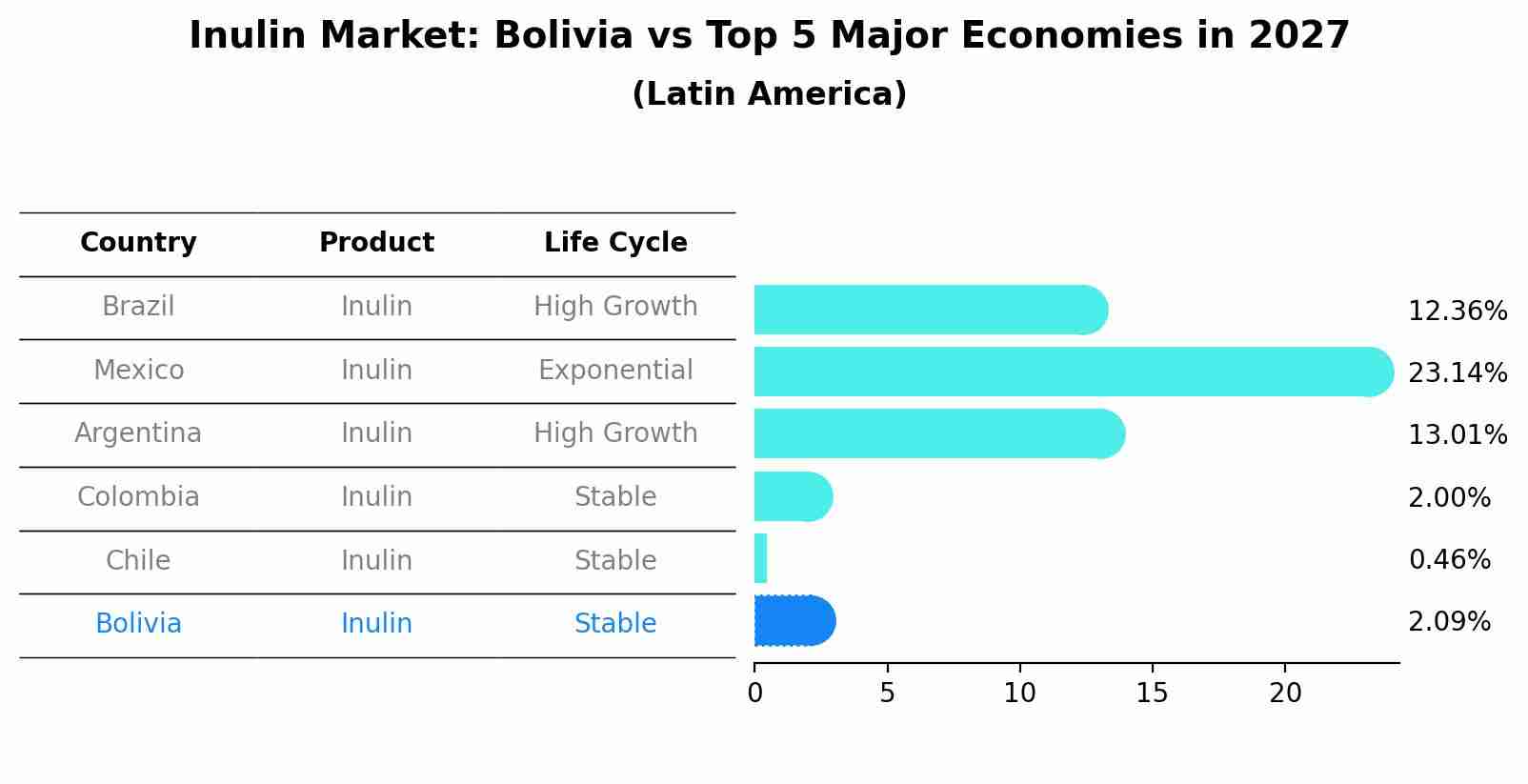Bolivia Inulin Market (2025-2031) | Analysis, Trends, Forecast, Share, Value, Revenue, Size, Industry, Growth, Outlook, Companies & Segmentation
| Product Code: ETC4846394 | Publication Date: Nov 2023 | Updated Date: Sep 2025 | Product Type: Market Research Report | |
| Publisher: 6Wresearch | Author: Sachin Kumar Rai | No. of Pages: 60 | No. of Figures: 30 | No. of Tables: 5 |
Bolivia Inulin Market Size Growth Rate
The Bolivia Inulin Market is projected to witness mixed growth rate patterns during 2025 to 2029. Starting at 1.67% in 2025, the market peaks at 2.22% in 2026, and settles at 2.02% by 2029.

Inulin Market: Bolivia vs Top 5 Major Economies in 2027 (Latin America)
In the Latin America region, the Inulin market in Bolivia is projected to expand at a stable growth rate of 2.09% by 2027. The largest economy is Brazil, followed by Mexico, Argentina, Colombia and Chile.

Bolivia Inulin Market Overview
The inulin market in Bolivia is growing as consumers become more health-conscious and seek natural dietary supplements. Inulin, a type of dietary fiber, is used for its prebiotic properties and health benefits, including improving digestive health and aiding weight management. The food and beverage industrys adoption of inulin as an ingredient in functional foods is also driving market growth.
Drivers of the market
The inulin market in Bolivia is supported by the growing demand for dietary fibers and functional ingredients in food and beverage products. Inulin is a type of soluble fiber that offers health benefits such as improved digestive health and blood sugar control. As Bolivia`s consumers seek healthier food options and functional ingredients, the demand for inulin rises. Additionally, advancements in inulin production technology and a focus on enhancing product applications and benefits drive market growth.
Challenges of the market
The inulin market in Bolivia is constrained by high import costs and a lack of local production capabilities. There is a need for investment in technology and infrastructure to support the development and application of inulin products. Additionally, limited market awareness and technical expertise related to inulin`s benefits and applications impact market growth.
Government Policy of the market
In Bolivia, policies for the inulin market focus on product safety, quality, and health benefits. Regulations may set standards for inulin purity, efficacy, and usage in dietary supplements and food products. The government may support research and development in inulin applications and offer incentives for businesses that ensure high-quality products and contribute to public health.
Key Highlights of the Report:
- Bolivia Inulin Market Outlook
- Market Size of Bolivia Inulin Market, 2024
- Forecast of Bolivia Inulin Market, 2031
- Historical Data and Forecast of Bolivia Inulin Revenues & Volume for the Period 2021-2031
- Bolivia Inulin Market Trend Evolution
- Bolivia Inulin Market Drivers and Challenges
- Bolivia Inulin Price Trends
- Bolivia Inulin Porter`s Five Forces
- Bolivia Inulin Industry Life Cycle
- Historical Data and Forecast of Bolivia Inulin Market Revenues & Volume By Form for the Period 2021-2031
- Historical Data and Forecast of Bolivia Inulin Market Revenues & Volume By Powder for the Period 2021-2031
- Historical Data and Forecast of Bolivia Inulin Market Revenues & Volume By Liquid for the Period 2021-2031
- Historical Data and Forecast of Bolivia Inulin Market Revenues & Volume By Nature for the Period 2021-2031
- Historical Data and Forecast of Bolivia Inulin Market Revenues & Volume By Organic for the Period 2021-2031
- Historical Data and Forecast of Bolivia Inulin Market Revenues & Volume By Conventional for the Period 2021-2031
- Historical Data and Forecast of Bolivia Inulin Market Revenues & Volume By Source for the Period 2021-2031
- Historical Data and Forecast of Bolivia Inulin Market Revenues & Volume By Agave for the Period 2021-2031
- Historical Data and Forecast of Bolivia Inulin Market Revenues & Volume By Chicory for the Period 2021-2031
- Historical Data and Forecast of Bolivia Inulin Market Revenues & Volume By Jerusalem Artichoke for the Period 2021-2031
- Historical Data and Forecast of Bolivia Inulin Market Revenues & Volume By Others for the Period 2021-2031
- Historical Data and Forecast of Bolivia Inulin Market Revenues & Volume By Application for the Period 2021-2031
- Historical Data and Forecast of Bolivia Inulin Market Revenues & Volume By Food & Beverages for the Period 2021-2031
- Historical Data and Forecast of Bolivia Inulin Market Revenues & Volume By Dietary Supplements for the Period 2021-2031
- Historical Data and Forecast of Bolivia Inulin Market Revenues & Volume By Pharmaceuticals for the Period 2021-2031
- Historical Data and Forecast of Bolivia Inulin Market Revenues & Volume By Animal Feed for the Period 2021-2031
- Bolivia Inulin Import Export Trade Statistics
- Market Opportunity Assessment By Form
- Market Opportunity Assessment By Nature
- Market Opportunity Assessment By Source
- Market Opportunity Assessment By Application
- Bolivia Inulin Top Companies Market Share
- Bolivia Inulin Competitive Benchmarking By Technical and Operational Parameters
- Bolivia Inulin Company Profiles
- Bolivia Inulin Key Strategic Recommendations
Frequently Asked Questions About the Market Study (FAQs):
1 Executive Summary |
2 Introduction |
2.1 Key Highlights of the Report |
2.2 Report Description |
2.3 Market Scope & Segmentation |
2.4 Research Methodology |
2.5 Assumptions |
3 Bolivia Inulin Market Overview |
3.1 Bolivia Country Macro Economic Indicators |
3.2 Bolivia Inulin Market Revenues & Volume, 2021 & 2031F |
3.3 Bolivia Inulin Market - Industry Life Cycle |
3.4 Bolivia Inulin Market - Porter's Five Forces |
3.5 Bolivia Inulin Market Revenues & Volume Share, By Form, 2021 & 2031F |
3.6 Bolivia Inulin Market Revenues & Volume Share, By Nature, 2021 & 2031F |
3.7 Bolivia Inulin Market Revenues & Volume Share, By Source, 2021 & 2031F |
3.8 Bolivia Inulin Market Revenues & Volume Share, By Application, 2021 & 2031F |
4 Bolivia Inulin Market Dynamics |
4.1 Impact Analysis |
4.2 Market Drivers |
4.2.1 Increasing consumer awareness about health benefits of inulin |
4.2.2 Growing demand for natural and organic food ingredients |
4.2.3 Rising prevalence of lifestyle diseases like obesity and diabetes |
4.3 Market Restraints |
4.3.1 Limited availability of raw materials for inulin production |
4.3.2 High production costs associated with inulin extraction and processing |
4.3.3 Lack of standardized regulations and quality control measures in the inulin market |
5 Bolivia Inulin Market Trends |
6 Bolivia Inulin Market Segmentations |
6.1 Bolivia Inulin Market, By Form |
6.1.1 Overview and Analysis |
6.1.2 Bolivia Inulin Market Revenues & Volume, By Powder, 2021-2031F |
6.1.3 Bolivia Inulin Market Revenues & Volume, By Liquid, 2021-2031F |
6.2 Bolivia Inulin Market, By Nature |
6.2.1 Overview and Analysis |
6.2.2 Bolivia Inulin Market Revenues & Volume, By Organic, 2021-2031F |
6.2.3 Bolivia Inulin Market Revenues & Volume, By Conventional, 2021-2031F |
6.3 Bolivia Inulin Market, By Source |
6.3.1 Overview and Analysis |
6.3.2 Bolivia Inulin Market Revenues & Volume, By Agave, 2021-2031F |
6.3.3 Bolivia Inulin Market Revenues & Volume, By Chicory, 2021-2031F |
6.3.4 Bolivia Inulin Market Revenues & Volume, By Jerusalem Artichoke, 2021-2031F |
6.3.5 Bolivia Inulin Market Revenues & Volume, By Others, 2021-2031F |
6.4 Bolivia Inulin Market, By Application |
6.4.1 Overview and Analysis |
6.4.2 Bolivia Inulin Market Revenues & Volume, By Food & Beverages, 2021-2031F |
6.4.3 Bolivia Inulin Market Revenues & Volume, By Dietary Supplements, 2021-2031F |
6.4.4 Bolivia Inulin Market Revenues & Volume, By Pharmaceuticals, 2021-2031F |
6.4.5 Bolivia Inulin Market Revenues & Volume, By Animal Feed, 2021-2031F |
7 Bolivia Inulin Market Import-Export Trade Statistics |
7.1 Bolivia Inulin Market Export to Major Countries |
7.2 Bolivia Inulin Market Imports from Major Countries |
8 Bolivia Inulin Market Key Performance Indicators |
8.1 Number of new product launches containing inulin |
8.2 Growth in the number of research studies highlighting health benefits of inulin |
8.3 Adoption rate of inulin in different food and beverage applications |
9 Bolivia Inulin Market - Opportunity Assessment |
9.1 Bolivia Inulin Market Opportunity Assessment, By Form, 2021 & 2031F |
9.2 Bolivia Inulin Market Opportunity Assessment, By Nature, 2021 & 2031F |
9.3 Bolivia Inulin Market Opportunity Assessment, By Source, 2021 & 2031F |
9.4 Bolivia Inulin Market Opportunity Assessment, By Application, 2021 & 2031F |
10 Bolivia Inulin Market - Competitive Landscape |
10.1 Bolivia Inulin Market Revenue Share, By Companies, 2024 |
10.2 Bolivia Inulin Market Competitive Benchmarking, By Operating and Technical Parameters |
11 Company Profiles |
12 Recommendations | 13 Disclaimer |
- Single User License$ 1,995
- Department License$ 2,400
- Site License$ 3,120
- Global License$ 3,795
Search
Related Reports
- ASEAN Bearings Market (2025-2031) | Strategy, Consumer Insights, Analysis, Investment Trends, Opportunities, Growth, Size, Share, Industry, Revenue, Segments, Value, Segmentation, Supply, Forecast, Restraints, Outlook, Competition, Drivers, Trends, Demand, Pricing Analysis, Competitive, Strategic Insights, Companies, Challenges
- Europe Flooring Market (2025-2031) | Outlook, Share, Industry, Trends, Forecast, Companies, Revenue, Size, Analysis, Growth & Value
- Saudi Arabia Manlift Market (2025-2031) | Outlook, Size, Growth, Trends, Companies, Industry, Revenue, Value, Share, Forecast & Analysis
- Uganda Excavator, Crane, and Wheel Loaders Market (2025-2031) | Strategy, Consumer Insights, Analysis, Investment Trends, Opportunities, Growth, Size, Share, Industry, Revenue, Segments, Value, Segmentation, Supply, Forecast, Restraints, Outlook, Competition, Drivers, Trends, Demand, Pricing Analysis, Competitive, Strategic Insights, Companies, Challenges
- Rwanda Excavator, Crane, and Wheel Loaders Market (2025-2031) | Strategy, Consumer Insights, Analysis, Investment Trends, Opportunities, Growth, Size, Share, Industry, Revenue, Segments, Value, Segmentation, Supply, Forecast, Restraints, Outlook, Competition, Drivers, Trends, Demand, Pricing Analysis, Competitive, Strategic Insights, Companies, Challenges
- Kenya Excavator, Crane, and Wheel Loaders Market (2025-2031) | Strategy, Consumer Insights, Analysis, Investment Trends, Opportunities, Growth, Size, Share, Industry, Revenue, Segments, Value, Segmentation, Supply, Forecast, Restraints, Outlook, Competition, Drivers, Trends, Demand, Pricing Analysis, Competitive, Strategic Insights, Companies, Challenges
- Angola Excavator, Crane, and Wheel Loaders Market (2025-2031) | Strategy, Consumer Insights, Analysis, Investment Trends, Opportunities, Growth, Size, Share, Industry, Revenue, Segments, Value, Segmentation, Supply, Forecast, Restraints, Outlook, Competition, Drivers, Trends, Demand, Pricing Analysis, Competitive, Strategic Insights, Companies, Challenges
- Israel Intelligent Transport System Market (2025-2031) | Strategy, Consumer Insights, Analysis, Investment Trends, Opportunities, Growth, Size, Share, Industry, Revenue, Segments, Value, Segmentation, Supply, Forecast, Restraints, Outlook, Competition, Drivers, Trends, Demand, Pricing Analysis, Competitive, Strategic Insights, Companies, Challenges
- Uganda Precast and Aggregate Market (2025-2031) | Strategy, Consumer Insights, Analysis, Investment Trends, Opportunities, Growth, Size, Share, Industry, Revenue, Segments, Value, Segmentation, Supply, Forecast, Restraints, Outlook, Competition, Drivers, Trends, Demand, Pricing Analysis, Competitive, Strategic Insights, Companies, Challenges
- Australia IT Asset Disposal Market (2025-2031) | Strategy, Consumer Insights, Analysis, Investment Trends, Opportunities, Growth, Size, Share, Industry, Revenue, Segments, Value, Segmentation, Supply, Forecast, Restraints, Outlook, Competition, Drivers, Trends, Demand, Pricing Analysis, Competitive, Strategic Insights, Companies, Challenges
Industry Events and Analyst Meet
Our Clients
Whitepaper
- Middle East & Africa Commercial Security Market Click here to view more.
- Middle East & Africa Fire Safety Systems & Equipment Market Click here to view more.
- GCC Drone Market Click here to view more.
- Middle East Lighting Fixture Market Click here to view more.
- GCC Physical & Perimeter Security Market Click here to view more.
6WResearch In News
- Doha a strategic location for EV manufacturing hub: IPA Qatar
- Demand for luxury TVs surging in the GCC, says Samsung
- Empowering Growth: The Thriving Journey of Bangladesh’s Cable Industry
- Demand for luxury TVs surging in the GCC, says Samsung
- Video call with a traditional healer? Once unthinkable, it’s now common in South Africa
- Intelligent Buildings To Smooth GCC’s Path To Net Zero













